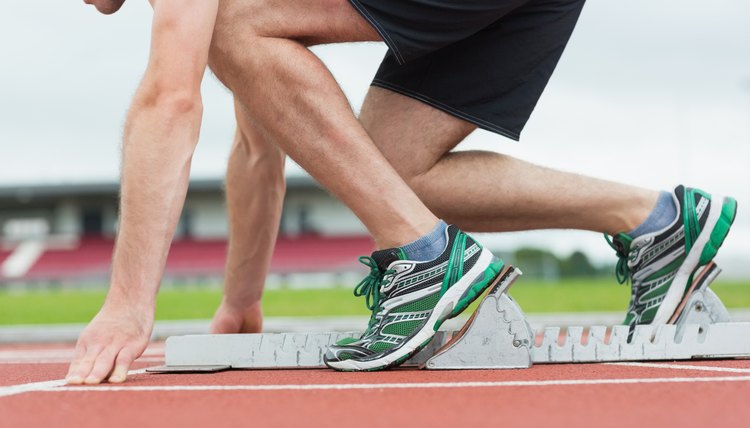How to Increase Turnover When Sprinting

Sprinting is all about speed, and the best way to increase your speed is to increase your turnover rate -- the rate at which your feet touch and push off from the track. Maximizing the power of each stride while minimizing the amount of time spent in contact with the ground requires focusing on seemingly minor details such as ankle motion and body position.
Sprint on a Treadmill
A simple and effective method for increasing your turnover rate on the track without worrying about the details is to try sprinting at high speeds on a treadmill. Because the treadmill belt essentially pulls your feet out from under you, it will force you to lift your feet quicker and take more efficient strides to avoid tangling yourself up. To use this approach, you must gradually increase the treadmill speed to a sprint unless you are proficient at mounting and dismounting a treadmill when it is moving at a high speed.
Concentrate on Dorsiflexion
One of the most important details in terms of sprint mechanics that can help you increase your speed is focus on dorsiflexion, the motion of bending your toes up toward your shin with each stride. This shortens the lever represented by your leg below the knee and puts your foot in a better position to absorb the shock of the landing while tensing your muscles for the next stride. Landing in a dorsiflexed position encourages a higher turnover rate by causing your foot and leg to act as a spring.
Turnover Drills
Dorsiflexing is easier said than done, so you should incorporate some quick feet sprinting drills into your pre-sprinting routine. Perform "high knees" with a focus on lifting your feet off the ground as quickly as possible and dorsiflexing as you do. "Quick feet" drills involve lifting your feet only to ankle height in rapid succession for about 20 yards at a time. "Butt kicks" encourage faster turnover by forcing you to get your leg up and down before collapsing onto your knee.
Downhill Running
Like running on a treadmill, running downhill forces you to adopt a faster turnover rate naturally. Running downhill forces you to work with gravity propelling you. To avoid falling, you might need to take shorter strides and make contact with the ground more frequently. Running downhill can be stressful on your joints and awkward in general. Leaning forward will alter your center of gravity, creating the risk of a fall, so adopt an upright upper-body position.
References
Writer Bio
Steven Kelliher is an experienced sports writer, technical writer, proofreader and editor based out of the Greater Boston Area. His main area of expertise is in combat sports, as he is a lifelong competitor and active voice in the industry. His interviews with some of the sport's biggest names have appeared on large industry sites such as ESPN.com, as well as his own personal blog.
